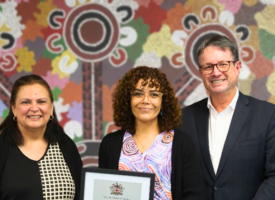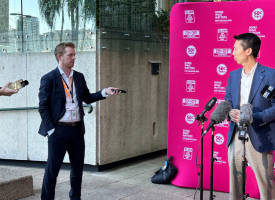Indigenous Ear Health - AMA Calls for action to end a 'life sentence' of harm
AMA Indigenous Health Report Card 2017: A National Strategic Approach to Ending Chronic Otitis Media and its Life Long Impacts in Indigenous Communities
The AMA today issued a challenge to all Australian governments to work with health experts and Indigenous communities to put an end to the scourge of poor ear health – led by chronic otitis media – affecting Aboriginal and Torres Strait Islander Australians.
At the launch of the 2017 AMA Indigenous Health Report Card in Canberra today, AMA President, Dr Michael Gannon, said the focus on ear health was part of the AMA’s step by step strategy to create awareness in the community and among political leaders of the unique and tragic health problems that have been eradicated in many parts of the world, but which still afflict Indigenous Australians.
The Report Card – A National Strategic Approach to Ending Chronic Otitis Media and its Life Long Impacts in Indigenous Communities – was launched by the Minister for Indigenous Health, The Hon Ken Wyatt AM.
“It is a tragedy that, in 21st century Australia, poor ear health, especially chronic otitis media, is still condemning Indigenous people to a life sentence of hearing problems – even deafness,” Dr Gannon said.
“Chronic otitis media is a disease of poverty, linked to poorer social determinants of health including unhygienic, overcrowded conditions, and an absence of health services.
“It should not be occurring here in Australia, one of the world’s richest nations. It is preventable.
“Otitis media is caused when fluid builds up in the middle ear cavity and becomes infected.
“While the condition lasts, mild or moderate hearing loss is experienced. If left untreated, it can lead to permanent hearing loss.”
Dr Gannon said that, for most non-Indigenous Australian children, otitis media is readily treated.
“The condition in the non-Indigenous population passes within weeks, and without long-term effects.
“But for many Aboriginal and Torres Strait Islander children, otitis media is not adequately treated. It persists in chronic forms over months and years. At worst, it is there for life.”
Estimates show that an average Indigenous child will endure middle ear infections and associated hearing loss for at least 32 months, from age two to 20 years, compared with just three months for a non-Indigenous child.
Dr Gannon said the AMA wants a national, systematic approach to closing the gap in the rates of chronic otitis media between Indigenous and non-Indigenous infants and children in Australia.
“We urgently need a coordinated national response to the lasting, disabling effects and social impacts of chronic otitis media in the Indigenous adult population,” Dr Gannon said.
“We urge our political leaders at all levels of government to take note of this Report Card and be motivated to act to implement solutions.”
The AMA calls on Australian governments to act on three core recommendations:
Recommendation 1:
That a coordinated national strategic response to chronic otitis media be developed by a National Indigenous Hearing Health Taskforce under Indigenous leadership for the Council of Australian Governments (COAG). This should build on and incorporate existing national and State and Territory level responses and include:
- a critical analysis of current approaches, and to identify the range of reasons that current chronic otitis media crisis persists;
- the development of a COAG Closing the Gap target about new cases of chronic otitis media and hearing loss in Indigenous infants and children under 12 years of age;
- a national otitis media surveillance program to monitor prevalence and support a targeted and cost-effective national response;
- a significantly increased focus on prevention - both primordial prevention with a focus on the social determinants of the disease, and primary prevention including family and community health literacy about otitis media;
- a central, adequately funded and supported role for primary health care and Aboriginal Community Controlled Health Services (ACCHS) in a systematic approach to the prevention, detection, treatment, and management of otitis media; and
- access to ear, nose and throat (ENT) specialists, particularly within ACCHS and other Indigenous-specific primary health care services, based on need.
Recommendation 2:
That the national approach proposed in Recommendation 1 include addressing the wider impacts of otitis media-related developmental impacts and hearing loss, including on a range of areas of Indigenous disadvantage such as through the funding of research as required. This includes:
- a national approach to supporting Indigenous students with hearing loss that aims to remove disadvantage that they may face in educational settings;
- a national approach to developing hearing loss-responsive communication strategies in all government and non-government agencies providing services to Indigenous people including - but not limited to - health, mental health, justice, and employment services; and
- exploring the support role of the National Disability Insurance Scheme (NDIS) to Indigenous people with hearing loss.
Recommendation 3:
That attention of governments be re-directed to the recommendations of the AMA’s 2015 Indigenous Health Report Card, which called for an integrated approach to reducing Indigenous imprisonment rates by addressing underlying causal health issues (including otitis media and related hearing loss and developmental impacts), with the expectation of appropriate action. The health issues to be addressed include mental health problems, cognitive disabilities, alcohol and drug problems, hearing loss, and developmental impacts associated with otitis media.
Background
- Indigenous children experience some of the highest rates of chronic suppuratives otitis media (CSOM) in the world.
- Chronic otitis media in infancy and childhood can affect Indigenous peoples’ adult health and wellbeing as much as cardiovascular disease or diabetes, and its effects are significant ‘life sentences’ of disability.
- Chronic otitis media has life-long impacts that bring greater risk of a range of adult social problems, not the least of which is incarceration. The association of chronic otitis media-related hearing loss and the high rates of Indigenous imprisonment has been noted for over 25 years now – but with little action evident.
The AMA Indigenous Health Report Card 2017 – A National Strategic Approach to Ending Chronic Otitis Media and its Life Long Impacts in Indigenous Communities– is at https://ama.com.au/article/2017-ama-report-card-indigenous-health-national-strategic-approach-ending-chronic-otitis
29 November 2017
CONTACT: John Flannery 02 6270 5477 / 0419 494 761
Maria Hawthorne 02 6270 5478 / 0427 209 753
Follow the AMA Media on Twitter: http://twitter.com/ama_media
Follow the AMA President on Twitter: http://twitter.com/amapresident
Follow Australian Medicine on Twitter: https://twitter.com/amaausmed
Like the AMA on Facebook https://www.facebook.com/AustralianMedicalAssociation



